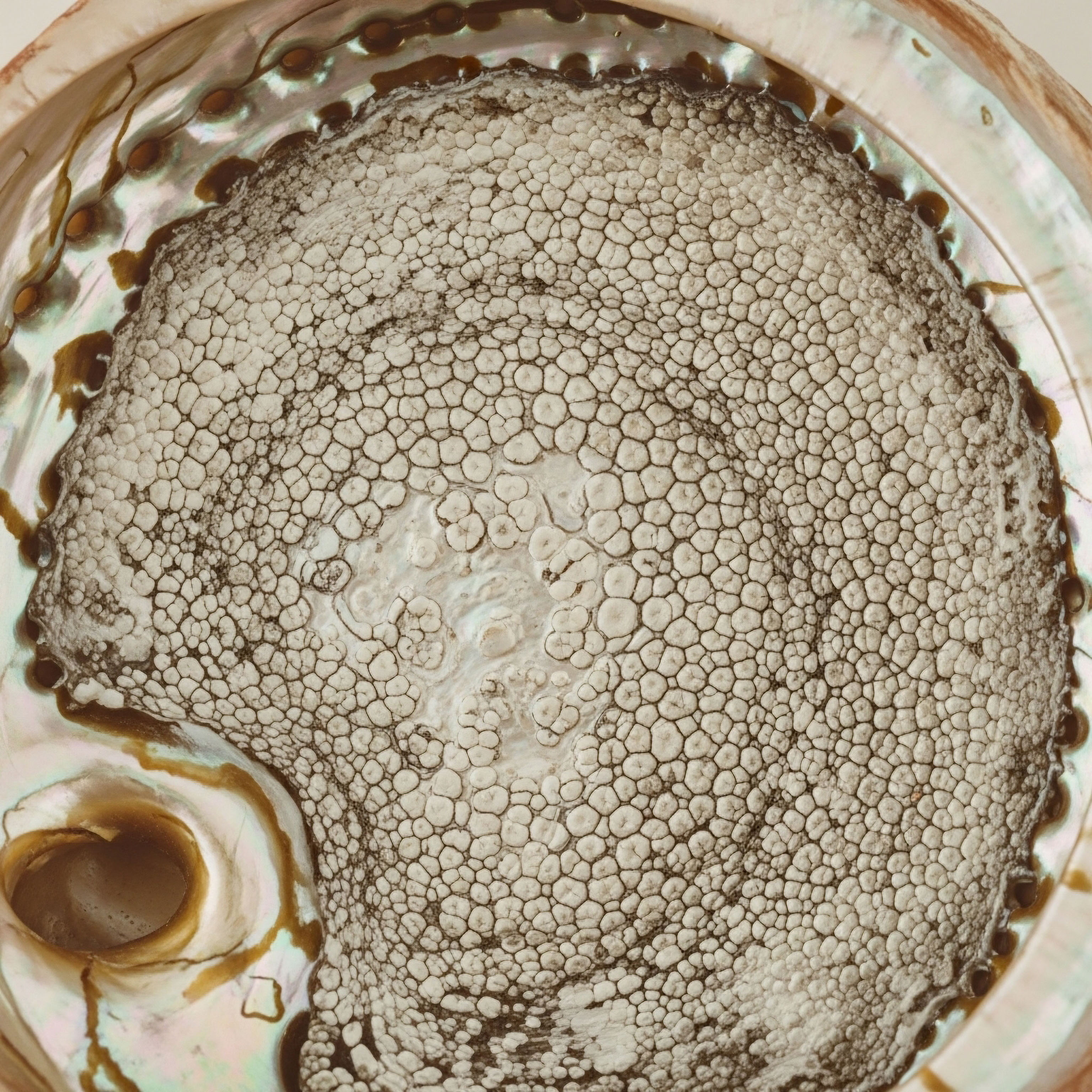

Fundamentals
You feel it before you can name it. A subtle shift in energy, a quiet dimming of the vitality that once defined your days. Your focus might feel less sharp, your resilience thinner. This experience, this lived reality of feeling a step-down in your own life, is a valid and important signal from your body.
It is a message that warrants deep listening. Often, these feelings are directly connected to the intricate internal communication network of your endocrine system, and specifically to testosterone. Testosterone is a profoundly important biomolecule for men and women, influencing everything from muscle and bone health to cognitive drive and mood. Its decline is frequently a barometer, a sensitive indicator of broader systemic imbalances within your body’s complex biological landscape.
Understanding the path to restoring hormonal health begins with appreciating the elegant system that governs it. The primary control center for testosterone production is the Hypothalamic-Pituitary-Gonadal (HPG) axis. This is a sophisticated feedback loop, a continuous biological conversation between your brain and your gonads.
The hypothalamus, a small and ancient part of your brain, acts as the system’s commander. It releases Gonadotropin-Releasing Hormone (GnRH) in precise, rhythmic pulses. These pulses are a direct instruction to the pituitary gland, the master gland situated just below it.
In response to GnRH, the pituitary releases two key messenger hormones into the bloodstream ∞ Luteinizing Hormone (LH) and Follicle-Stimulating Hormone (FSH). For men, LH travels to the Leydig cells in the testes, delivering the explicit command to produce testosterone. The success of this entire elegant cascade, and thus your ability to naturally restore testosterone, depends on the clarity and strength of these signals at every step of the chain.
The body’s ability to produce testosterone is governed by a precise signaling cascade known as the Hypothalamic-Pituitary-Gonadal axis.

The Foundational Pillars of Hormonal Integrity
The HPG axis does not operate in isolation. Its function is exquisitely sensitive to the overall environment of your body. The success of any natural restoration protocol is therefore built upon a foundation of core physiological pillars. When these pillars are strong, they provide the stability your endocrine system needs to function optimally. When they are compromised, they create static and interference that disrupts the delicate hormonal conversation of the HPG axis.

Sleep Architecture the Nightly Reset
Deep, restorative sleep is a non-negotiable requirement for a healthy endocrine system. The majority of LH and subsequent testosterone release occurs during the night, synchronized with your natural sleep cycles. Fragmented or insufficient sleep directly blunts the pituitary’s ability to send those crucial signals.
Think of it as trying to have a vital conversation in a room full of shouting. The message from the pituitary to the testes becomes weak and indistinct. Research has demonstrated that even a single week of sleep restriction can significantly decrease daytime testosterone levels in healthy young men. Re-establishing a consistent sleep schedule and improving sleep quality is a primary and powerful lever in supporting your body’s innate capacity for hormone production.

Metabolic Health the Body’s Energy Economy
Your metabolic health is intrinsically linked to your hormonal status. Being overweight or obese, particularly with excess visceral fat around the organs, creates a state of metabolic disruption that directly undermines testosterone. Adipose tissue, or body fat, is not simply inert storage.
It is a metabolically active organ that produces its own set of hormones and inflammatory molecules. Crucially, it is a primary site of aromatase activity. Aromatase is an enzyme that converts testosterone directly into estrogen. In a state of excess body fat, this conversion process accelerates, actively depleting your circulating testosterone while increasing estrogen levels, further disrupting the sensitive hormonal balance the HPG axis strives to maintain.

Movement and Muscle a Signal of Demand
Regular physical activity, especially resistance training, sends a powerful signal throughout the body. The act of contracting muscles under load does more than build strength. It improves insulin sensitivity, which helps to manage the metabolic disruption mentioned earlier. Better insulin sensitivity means your body can manage blood sugar more effectively, reducing the chronic inflammation and hormonal interference associated with metabolic dysfunction.
Exercise signals a fundamental biological need for repair, growth, and anabolic processes, the very processes that testosterone governs. This creates a systemic environment that is conducive to, and demanding of, optimal testosterone function.


Intermediate
Moving beyond the foundational pillars of health, a more sophisticated understanding of natural testosterone restoration requires examining the specific biochemical disruptors that interfere with the HPG axis. These are the hidden stressors that can silently sabotage your body’s efforts to achieve hormonal balance, even when you are actively addressing diet, exercise, and sleep.
Success in restoration is often determined by identifying and mitigating these more nuanced physiological burdens. The conversation within the HPG axis is a delicate one, and these factors introduce significant noise into the system, weakening the signal at its source or corrupting its reception.

How Does Systemic Stress Modulate Hormone Production?
Your body is equipped with a powerful system for managing acute threats, orchestrated by the adrenal glands and their primary stress hormone, cortisol. This system is designed for short-term survival. In the modern world, many individuals experience chronic, low-level stress, which leads to persistently elevated cortisol levels.
This chronic activation has profound consequences for the HPG axis. Cortisol acts as a direct antagonist to testosterone production through several mechanisms. Firstly, it sends a powerful inhibitory signal to the hypothalamus, suppressing the release of GnRH. This is a biological triage mechanism. when the body perceives itself to be under constant threat, it deprioritizes long-term functions like reproduction and tissue building in favor of immediate survival. The command to produce testosterone is effectively turned down at the source.
Secondly, at a biochemical level, both cortisol and testosterone are synthesized from the same precursor molecule, pregnenolone. Under conditions of chronic stress, the body shunts a greater proportion of this shared resource down the pathway to produce cortisol. This phenomenon leaves fewer raw materials available for the synthesis of testosterone in the testes.
The persistent demand for stress hormones effectively starves the pathway for anabolic hormones. This is a direct biochemical competition where chronic stress consistently wins, creating a systemic environment that is biochemically tilted away from healthy testosterone production.

The Central Role of Insulin Resistance
Insulin resistance is a condition where your body’s cells become less responsive to the effects of insulin, the hormone that manages blood sugar. This state, often preceding type 2 diabetes, is a potent disruptor of male endocrine health. Chronically high levels of insulin in the bloodstream, a hallmark of insulin resistance, appear to directly impair the pituitary’s ability to secrete Luteinizing Hormone (LH).
The signal from the pituitary to the testes becomes blunted and irregular. The precise pulsatility of LH is critical for stimulating the Leydig cells effectively, and insulin resistance throws this rhythm into disarray. Furthermore, as mentioned previously, the excess adipose tissue that typically accompanies insulin resistance is a hotbed of aromatase activity.
This enzyme actively converts testosterone into estradiol, an estrogen. The result is a dual assault on hormonal balance ∞ diminished production due to impaired LH signaling and increased depletion due to accelerated conversion to estrogen. Addressing insulin sensitivity is therefore a central objective in any serious protocol for natural testosterone restoration.
Chronic physiological stressors like elevated cortisol and insulin resistance directly suppress the signaling cascade required for optimal testosterone synthesis.
The following table illustrates how different lifestyle stressors impact the key components of the Hypothalamic-Pituitary-Gonadal axis, providing a clearer picture of these interconnected pathways.
| Stressor | Impact on Hypothalamus (GnRH Release) | Impact on Pituitary (LH/FSH Release) | Impact on Testes (Testosterone Production) |
|---|---|---|---|
| Chronic Sleep Deprivation |
Disrupts the nocturnal pulsatility and amplitude of GnRH signals. |
Significantly reduces the primary overnight surge of LH. |
Leads to lower morning testosterone levels due to insufficient stimulation. |
| Elevated Cortisol (Chronic Stress) |
Directly suppresses GnRH secretion, downregulating the entire axis. |
Can blunt pituitary sensitivity to GnRH signals over time. |
Shunts pregnenolone precursor away from testosterone synthesis toward cortisol production. |
| High Insulin Levels (Insulin Resistance) |
May indirectly alter GnRH pulsatility through crosstalk with metabolic hormones like leptin. |
Directly impairs the ability of the pituitary to secrete LH effectively. |
Increased aromatase activity in associated adipose tissue converts testosterone to estrogen. |

Nutrient Cofactors the Essential Building Blocks
Hormones are not created from nothing. Their synthesis is a complex biochemical process that depends on a steady supply of specific micronutrient cofactors. Deficiencies in these key vitamins and minerals can create significant bottlenecks in the testosterone production pathway, even if the HPG axis signaling is perfectly intact. Understanding these nutritional requirements is a critical component of building a successful restoration strategy.
- Zinc This essential mineral plays a multifaceted role in male endocrine health. It is directly involved in the synthesis of testosterone within the Leydig cells. Zinc also acts at the level of the pituitary gland, influencing the release of both LH and FSH. A deficiency in zinc can therefore impair the hormonal cascade at multiple points, leading to suppressed testosterone output.
- Vitamin D Functioning more like a pro-hormone than a vitamin, Vitamin D receptors are found on cells in the hypothalamus, the pituitary, and the testes. This suggests its importance across the entire HPG axis. Clinical research has shown a strong correlation between higher Vitamin D levels and higher circulating testosterone. While the precise mechanisms are still being fully elucidated, its role as a fundamental regulator of endocrine function is clear.
- Magnesium This mineral is involved in hundreds of enzymatic reactions throughout the body, including those related to hormone metabolism. Magnesium appears to influence how testosterone interacts with proteins in the blood. A significant portion of testosterone is bound to a protein called Sex Hormone-Binding Globulin (SHBG), which renders it inactive. Magnesium may help to reduce the amount of testosterone that gets bound to SHBG, thereby increasing the amount of “free” testosterone that is biologically available to interact with cells and exert its effects.


Academic
An academic exploration into the success of natural testosterone restoration requires a shift in perspective, moving from isolated factors to a systems-biology framework. The central thesis is that functional testosterone status is an emergent property of a well-regulated biological system.
Consequently, the failure to restore it naturally is often a reflection of a high allostatic load, where multiple, interconnected physiological systems are dysregulated. The burden of systemic disease, particularly the triad of metabolic syndrome, chronic low-grade inflammation, and gut dysbiosis, presents the most significant impediment to the endogenous recovery of the Hypothalamic-Pituitary-Gonadal (HPG) axis. This section will dissect the intricate molecular crosstalk between these systems, demonstrating how they collectively suppress testicular steroidogenesis and render simple interventions ineffective.

Metabolic Endotoxemia and Leydig Cell Suppression
The integrity of the gastrointestinal barrier is a critical, yet often overlooked, regulator of systemic inflammation and, by extension, endocrine function. In conditions of gut dysbiosis and increased intestinal permeability, fragments of gram-negative bacteria, specifically lipopolysaccharides (LPS), can translocate from the gut lumen into systemic circulation.
This condition, known as metabolic endotoxemia, triggers a potent inflammatory response. Circulating LPS binds to Toll-like receptor 4 (TLR4), which is expressed not only on immune cells but also directly on the Leydig cells of the testes. The activation of TLR4 on Leydig cells initiates an intracellular inflammatory cascade.
This cascade inhibits the expression of key steroidogenic enzymes, including Cytochrome P450scc (which converts cholesterol to pregnenolone) and 17β-hydroxysteroid dehydrogenase (which performs the final conversion to testosterone). The result is a direct, inflammation-mediated suppression of testosterone synthesis at the gonadal level, independent of any signaling deficits from the pituitary or hypothalamus.
This mechanism explains why individuals with underlying gut health issues may fail to see improvements in testosterone despite addressing other lifestyle factors. The constant inflammatory signaling from the gut effectively places a brake on the testicular machinery.

The Interplay of Adipokines and GnRH Pulsatility
Visceral adipose tissue, a key component of metabolic syndrome, functions as a highly active endocrine organ, secreting a variety of signaling molecules called adipokines. Two of the most important adipokines in the context of HPG axis regulation are leptin and adiponectin. Leptin, the satiety hormone, has a complex and biphasic relationship with the HPG axis.
While it is necessary for the initiation of puberty and normal reproductive function, chronically elevated leptin levels, a condition known as leptin resistance common in obesity, exert a suppressive effect on the HPG axis. High leptin levels can disrupt the precise, rhythmic pulsation of GnRH from the hypothalamus.
This loss of pulsatility desensitizes the pituitary gonadotroph cells to the GnRH signal, leading to attenuated LH release and subsequent reduction in testicular stimulation. Adiponectin, conversely, is generally considered to have a sensitizing effect on metabolic and endocrine pathways. In obesity, adiponectin levels are typically low.
This relative deficiency of adiponectin further contributes to the systemic insulin resistance and inflammation that negatively impact Leydig cell function. The altered ratio of these adipokines creates a signaling environment that is fundamentally hostile to robust HPG axis function.
The success of natural testosterone restoration is fundamentally dependent on mitigating the systemic inflammatory burden originating from metabolic and gut-related dysregulation.
The following table provides a conceptual overview of the correlation between key biomarkers of systemic inflammation and metabolic dysregulation and their typical impact on testosterone levels. This illustrates the dose-dependent relationship between systemic health and endocrine output.
| Biomarker | Clinical Significance | Typical Correlation with Free Testosterone | Primary Mechanism of Impact |
|---|---|---|---|
| High-Sensitivity C-Reactive Protein (hs-CRP) |
A primary marker of systemic inflammation. |
Strongly negative. |
Reflects the inflammatory load that can directly suppress Leydig cell function and hypothalamic output. |
| Homeostatic Model Assessment of Insulin Resistance (HOMA-IR) |
A measure of insulin resistance. |
Strongly negative. |
High insulin levels impair pituitary LH release and promote aromatization of testosterone to estrogen. |
| Sex Hormone-Binding Globulin (SHBG) |
Binds to testosterone, making it inactive. |
Complex; high SHBG lowers free T. |
Levels are influenced by insulin and inflammation. High insulin often lowers SHBG, but the rise in estrogen can sometimes increase it. |
| Lipopolysaccharide (LPS) |
Marker of metabolic endotoxemia from gut permeability. |
Strongly negative. |
Directly activates inflammatory pathways in Leydig cells, inhibiting steroidogenic enzymes. |

What Is the Genetic Influence on Testosterone Levels?
While environmental and lifestyle factors are potent modulators of testosterone, it is crucial to acknowledge the influence of an individual’s genetic background. Genetic polymorphisms can affect everything from the baseline activity of the HPG axis to the efficiency of steroidogenic enzymes and the density and sensitivity of androgen receptors throughout the body.
For instance, variations in the gene for SHBG can lead to significant differences in the amount of bioavailable testosterone between individuals, even if their total testosterone production is identical. Similarly, genetic predispositions to conditions like metabolic syndrome or inflammatory disorders can indirectly dictate an individual’s hormonal resilience.
While one cannot change their genes, understanding this baseline can help set realistic expectations for the degree of restoration possible through natural interventions alone. For some individuals with specific genetic conditions, such as Klinefelter’s syndrome, endogenous production is severely compromised, and natural restoration is not a viable clinical goal. For most, however, genes define a potential range, and lifestyle factors determine where within that range an individual functions.
- SHBG Gene Variants Polymorphisms in the SHBG gene can significantly alter the binding affinity and circulating levels of this protein. Individuals with variants that lead to higher SHBG levels will naturally have lower free testosterone, making them more susceptible to symptoms of deficiency even with “normal” total testosterone.
- Aromatase (CYP19A1) Gene Variations in the gene encoding the aromatase enzyme can influence its activity. Individuals with a more active variant may convert testosterone to estrogen at a higher rate, particularly in the context of obesity, predisposing them to hormonal imbalance.
- Androgen Receptor (AR) Gene The sensitivity of the body’s tissues to testosterone is determined by the androgen receptor. The length of a specific segment of the AR gene (the CAG repeat) has been shown to inversely correlate with receptor sensitivity. Longer repeats are associated with lower sensitivity, meaning more testosterone is required to achieve the same biological effect.

References
- Mulligan, T. Frick, M. F. Zuraw, Q. C. Stemhagen, A. & McWhirter, C. (2006). Prevalence of hypogonadism in males aged at least 45 years ∞ the HIM study. International journal of clinical practice, 60 (7), 762 ∞ 769.
- Pellitero, S. Olaechea, P. & Granada, M. L. (2019). Prevalence of hypogonadism in male patients with type 2 diabetes mellitus. Journal of Clinical Medicine, 8 (12), 2056.
- Leproult, R. & Van Cauter, E. (2011). Effect of 1 week of sleep restriction on testosterone levels in young healthy men. JAMA, 305 (21), 2173 ∞ 2174.
- Rastrelli, G. Corona, G. & Maggi, M. (2018). Testosterone and benign prostatic hyperplasia. Sexual medicine reviews, 6 (3), 474-485.
- Traish, A. M. (2014). Benefits and health implications of testosterone therapy in men with testosterone deficiency. Sexual medicine reviews, 2 (1), 86-104.
- Dandona, P. & Rosenberg, M. T. (2010). A practical guide to male hypogonadism in the primary care setting. The International Journal of Clinical Practice, 64 (6), 682-696.
- Harman, S. M. Metter, E. J. Tobin, J. D. Pearson, J. & Blackman, M. R. (2001). Longitudinal effects of aging on serum total and free testosterone levels in healthy men. The Journal of Clinical Endocrinology & Metabolism, 86 (2), 724-731.
- Kelly, D. M. & Jones, T. H. (2013). Testosterone ∞ a metabolic hormone in health and disease. Journal of Endocrinology, 217 (3), R25-R45.
- Tremellen, K. (2016). Gut-endotoxemia and testosterone-mediated inflammation ∞ the new frontier in the diagnosis and treatment of male infertility. Journal of clinical medicine, 5 (8), 74.
- Grossmann, M. (2011). Low testosterone in men with type 2 diabetes ∞ significance and treatment. The Journal of Clinical Endocrinology & Metabolism, 96 (8), 2341-2353.

Reflection

Charting Your Own Biological Course
The information presented here offers a map of the complex biological territory that governs your hormonal health. This map details the interconnected systems, the critical signaling pathways, and the potential points of disruption. Its purpose is to illuminate the profound connection between how you feel and the intricate processes occurring within your cells.
This knowledge is the first and most vital step. It transforms the conversation from one of passive suffering to one of active, informed investigation. Your unique symptoms and your personal health history are the starting coordinates on this map.
The journey toward restoring vitality is a process of understanding your own specific landscape, identifying the unique burdens your system is carrying, and systematically removing them. It is a path of rebuilding your physiology from the ground up. This knowledge empowers you to ask deeper questions and to seek solutions that address the root of the imbalance, allowing you to become the primary agent in the reclamation of your own health and function.

Glossary

testosterone production

leydig cells

hpg axis

testosterone levels

adipose tissue

aromatase activity

natural testosterone restoration requires

chronic stress

insulin resistance

natural testosterone restoration

hypothalamic-pituitary-gonadal axis

gnrh pulsatility

sex hormone-binding globulin

testosterone restoration

metabolic syndrome

steroidogenesis

systemic inflammation

metabolic endotoxemia

adipokines

leydig cell function

leydig cell




